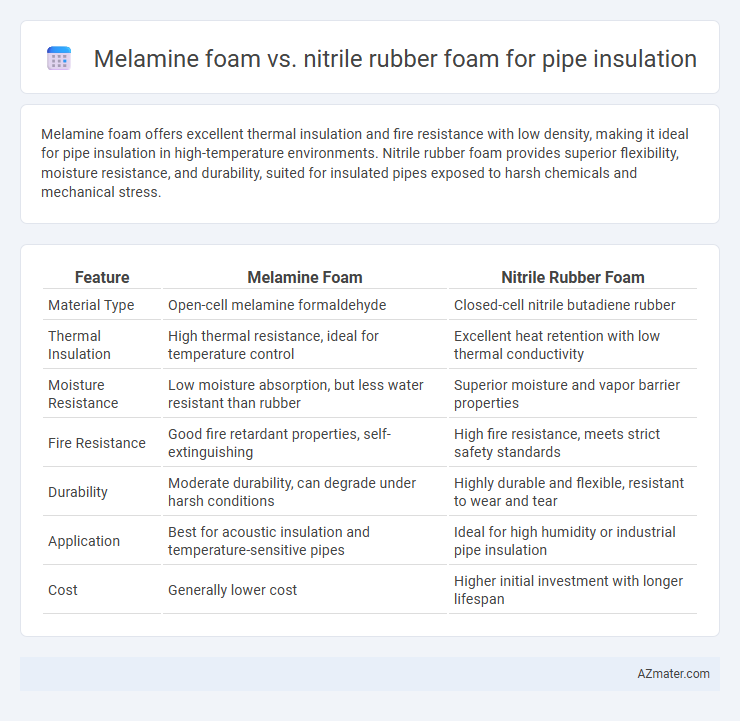Melamine foam offers excellent thermal insulation and fire resistance with low density, making it ideal for pipe insulation in high-temperature environments. Nitrile rubber foam provides superior flexibility, moisture resistance, and durability, suited for insulated pipes exposed to harsh chemicals and mechanical stress.
Table of Comparison
| Feature | Melamine Foam | Nitrile Rubber Foam |
|---|---|---|
| Material Type | Open-cell melamine formaldehyde | Closed-cell nitrile butadiene rubber |
| Thermal Insulation | High thermal resistance, ideal for temperature control | Excellent heat retention with low thermal conductivity |
| Moisture Resistance | Low moisture absorption, but less water resistant than rubber | Superior moisture and vapor barrier properties |
| Fire Resistance | Good fire retardant properties, self-extinguishing | High fire resistance, meets strict safety standards |
| Durability | Moderate durability, can degrade under harsh conditions | Highly durable and flexible, resistant to wear and tear |
| Application | Best for acoustic insulation and temperature-sensitive pipes | Ideal for high humidity or industrial pipe insulation |
| Cost | Generally lower cost | Higher initial investment with longer lifespan |
Introduction to Pipe Insulation Materials
Melamine foam and nitrile rubber foam are widely used materials for pipe insulation due to their unique thermal and acoustic properties. Melamine foam offers excellent sound absorption and fire resistance, making it ideal for applications demanding high thermal insulation and noise reduction. Nitrile rubber foam provides superior flexibility, moisture resistance, and durability, which suits industrial and HVAC pipe insulation systems where long-term performance and resistance to chemicals are critical.
What is Melamine Foam?
Melamine foam is a lightweight, open-cell elastomeric material renowned for its excellent sound absorption and thermal insulation properties, making it ideal for pipe insulation applications. Its structure provides superior fire resistance and low thermal conductivity compared to nitrile rubber foam, enhancing energy efficiency in industrial and residential piping systems. Melamine foam also offers effective moisture resistance and durability, ensuring long-lasting insulation performance in diverse environmental conditions.
What is Nitrile Rubber Foam?
Nitrile rubber foam is a synthetic elastomer known for its excellent resistance to oil, chemicals, and temperature fluctuations, making it ideal for pipe insulation in industrial and commercial settings. Its closed-cell structure provides superior thermal insulation and moisture resistance compared to traditional materials. This foam's durability and flexibility ensure long-lasting protection against heat loss and external contaminants in HVAC and plumbing systems.
Thermal Insulation Properties: Melamine vs Nitrile Rubber
Melamine foam exhibits a low thermal conductivity of approximately 0.03 W/m*K, providing excellent thermal insulation and fire resistance for pipe applications. Nitrile rubber foam offers slightly higher thermal conductivity values around 0.035 to 0.040 W/m*K but excels in flexibility and moisture resistance, making it suitable for dynamic environments. Choosing between melamine and nitrile rubber foam for pipe insulation depends on prioritizing superior thermal insulation and fire retardancy versus enhanced moisture protection and mechanical durability.
Fire Resistance Comparison
Melamine foam exhibits superior fire resistance compared to nitrile rubber foam, as it is inherently flame-retardant and can resist ignition without emitting toxic gases. Nitrile rubber foam, while offering good insulation properties, is more prone to combustion and releases hazardous smoke under high temperatures. Industries requiring stringent fire safety standards often prefer melamine foam for pipe insulation to enhance overall fire protection and compliance.
Durability and Lifespan of Insulation Materials
Melamine foam offers excellent thermal insulation but has limited durability, often degrading under prolonged exposure to moisture and mechanical stress, resulting in a shorter lifespan for pipe insulation. Nitrile rubber foam provides superior durability with high resistance to water, oils, and physical wear, extending the lifespan of insulation systems significantly in demanding industrial environments. The choice between these materials depends on application requirements, with nitrile rubber foam generally preferred for long-term, high-performance pipe insulation due to its robust durability.
Moisture and Mold Resistance
Melamine foam exhibits superior moisture and mold resistance compared to nitrile rubber foam, making it ideal for pipe insulation in humid or wet environments. Its open-cell, hydrophobic structure prevents water absorption and inhibits mold growth, ensuring long-term durability and hygiene. Nitrile rubber foam, while flexible and resilient, tends to absorb moisture over time, which can promote mold development and reduce insulation efficiency.
Ease of Installation and Flexibility
Melamine foam offers superior flexibility, allowing it to easily conform to complex pipe shapes, making installation faster and more efficient. Nitrile rubber foam, while slightly less flexible, provides good compressibility and resilience, which supports quick fitting around pipes but may require more precise measurements. Both materials are lightweight and easy to handle, but melamine foam's open-cell structure enhances its adaptability during installation in tight or irregular spaces.
Cost Analysis: Melamine Foam vs Nitrile Rubber
Melamine foam insulation typically costs less than nitrile rubber foam, making it a budget-friendly option for pipe insulation projects. Nitrile rubber foam offers higher durability and better resistance to oils and chemicals, but its initial investment is considerably higher. For long-term cost efficiency, consider the balance between upfront expenses and maintenance savings, as nitrile rubber foam may reduce replacement frequency compared to melamine foam.
Applications and Best Use Cases
Melamine foam offers excellent thermal insulation and sound absorption, making it ideal for cooling pipes and HVAC systems exposed to moderate temperatures and requiring fire resistance. Nitrile rubber foam excels in flexible, waterproof pipe insulation applications, particularly in industrial and automotive settings where resistance to oils, chemicals, and higher temperatures is crucial. For optimal performance, melamine foam suits indoor environments prioritizing fire retardancy and acoustic control, while nitrile rubber foam is best for outdoor or harsh environments needing durability and moisture protection.

Infographic: Melamine foam vs Nitrile rubber foam for Pipe insulation
 azmater.com
azmater.com